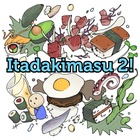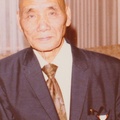In Seattle, my family’s mushroom hunting season would begin with discussions around the big table in the large, windowed breakfast nook at home, where the family took all everyday meals. Around the dinner table, rumors about friends and acquaintances being recognized at various well-known matsutake sites in the Cascades, the Olympic Peninsula, and Shelton were thoroughly analyzed. One year, matsutake were found under huckleberry bushes, an inconceivable place! Every Japanese family had their own, secret matsutake hunting places, locations which were family treasures. We children were sworn to secrecy and sternly admonished not to utter the names of the matsutake places to anyone, not even to our cousins. When my parents learned that my husband-to-be, Hank Yamamura and I were going mushroom hunting, I was pointedly reminded not to give away the family’s secret mushroom hunting locations.
I remember an unforgettable mushroom hunting expedition when Mom cooked matsutake sukiyaki in a camping area close to where we found a huge number of matsutake. After a long drive into the Cascade Mountains, we reached our secret spot and parking carefully out of sight of the main highway, we plotted separate paths to cover more territory. Stepping out of the car, we were greeted with the fragrant smell of moist greenness and evergreen trees. Mom, Louise, and I went up a wide path while Dad and Grandma and Grandpa went on two different searches, on the other side of the main highway. We started boldly upward but soon tired, sometimes wandering a little off the path to look under a raised lump of moss or inspect a whitish mushroom, seeking the huge boletus kind of matsutake in full bloom. Even more prized, was a find of a white bud of matsutake, perfect for thin slivers to infuse flavor into a clear mushroom soup. If any strangers were encountered on the trail, we were careful to conceal our mushroom hunting activities.
True matsutake—there are several varieties of matsutake—all have a wonderful and utterly distinctive aroma. They smell like they taste. At first, when either my sister Louise or I thought we’d spotted a mushroom, we’d call out and have the adults verify that it was a genuine matsutake. Genuine matsutake were carefully dug up, as much dirt as possible gently removed, wrapped in paper, and placed in an old flour sack.
We found lots of mushrooms that day and trudged back down the trail, old flour sacks bulging with matsutake. We met Grandma, Grandpa, and Dad, all carrying filled sacks and we barely got all of us with full sacks of mushrooms into the car. Grandma also had a few branches of brilliantly colored maple leaves. These would be arranged at home into an ikebana style display with three asymmetrical points symbolizing heaven, man, and earth. By now, after several hours of climbing and walking, we were all very hungry and not just a little tired too.
Dad drove us to a campground, which had a drinking water spigot. Mom washed the rice kernels and set the freshly washed rice to cook on the first burner of the two-burner Coleman stove. We usually soaked the rice in water for a few hours but today we didn’t have time. After the rice had “blown” steam for the first time and the usual mess of foaming water flowed out of the rice pot, we knew it was well on its way to being cooked. The flame under the rice was lowered. In the meantime, Mom washed some of the largest of the matsutake, sliced them into meaty pieces, sliced the onions, sliced the celery, opened the cans of yam noodles, got out a shoyu bottle, and was ready to make sukiyaki.
For the life of me, I can’t remember now in which order Mom added the sukiyaki ingredients to the deep frying pan she put on the other burner of the portable gas Coleman stove. I know it is very important to add the ingredients in the right order. It seems to me that Mom added the meat last, rather than first. Whatever Mom’s order was, I do recall that it was opposite from Mom Yamamura’s style of sukiyaki making. I think Mom covered the partially cooked vegetables with a layer of meat because she believed the transparently thin slices of beef would overcook if added first. I guess I’m conflicted because Hank’s Mom was also a wonderful cook. I loved her as dearly as my own Mom. I want both of them to be “right” and so they are.
Whatever Mom did, the resulting sukiyaki was delicious. Mom’s vitality and good humor shone around her like a bright halo. She exuded strength, moved quickly, and was never as happy as when preparing a good meal, which she knew was eagerly anticipated by all of us. We got hot, freshly prepared rice to go with the savory, matsutake flavored sukiyaki, pre-prepared teriyaki chicken, and hot green tea. What a feast!
I would give almost anything to have that meal again, with Mom in all her glory, Dad standing quietly by with arms folded over his chest, fly fishing hat pushed back on his head, looking pleased, and Grandma and Grandpa Araki sitting at a picnic table with Louise and me. We’d had a day filled with fun, adventures, delicious food, and would return home laden with wonderful gifts to give to family and friends.
The matsutake sukiyaki that I experienced long ago in the Cascades is impossible to make now. It was not so much the eating of matsutake but the searching for them, the finding of them in the company of loving family, and Mother’s happy preparation of the feast that made the matsutake sukiyaki delicious beyond compare. Many ”ingredients” for this repast no longer exist. Time has burnished, to a golden and rosy glow, this precious childhood memory of a time long ago.
* This article is a condensed version of Chapter 7 from CAMP 1942 and the Rest of My Life by Susan (Araki) Yamamura, 2014.
* * * * *
Our Editorial Committees selected this article as one of their favorite Itadakimasu 2! stories. Here are their comments.
Comment by Nancy Matsumoto
The many varieties of Nikkei history, family life, and foodways evoked in Itadakimasu 2! made each essay a pleasure to read, and a “favorite” hard to pick. What stood out about Susan Yamamura’s Matsutake Sukiyaki though, was how, in simple, direct and affecting language, she expresses her deep love for departed family members while recalling a long-ago mushroom hunt and family dinner.
There’s an understated humor to her account of the seriousness and secrecy of the matsutake hunt (even her husband-to-be is not to be trusted with knowledge of top-secret family hunting sites!). In the evocative final campground cooking scene, her mother joyfully assembles the matsutake sukiyaki dinner. We’re so immersed in the story that it almost comes as a surprise when the camera pulls back and the narrator reminds us that the dinner could not be recreated today because many of its “ingredients” no longer exist. What has seemed so real, to the narrator and to us, is in fact a precious childhood memory, “burnished to a golden and rosy glow.”
Comment by Soji Kashiwagi
As a Japanese American, I’ve seen matsutake being sold in J-Town supermarkets for prices way beyond what I could afford. I’ve heard about JA families going out to remote and secret locations up in the mountains in search of “mushroom gold.” But I’ve never truly experienced the hunt for matsutake until Susan Yamamura took me to the Cascade Mountains of Washington state in her story, Matsutake Sukiyaki. This uniquely JA journey she took me on—from the family planning, to reaching the family’s “secret spot,” to her description of the beautiful scenery—was everything I could ask for. But what brought this story home for me was the family’s return to their campsite and her mother’s careful and loving preparation of the matsutake sukiyaki. With her mom, dad, sister and grandparents around the table, it was definitely a meal to remember and savor for the ages. My only hope is that Susan makes matsutake sukiyaki once again—and passes on the matsutake-hunting tradition, the flavors and her delicious story on to members of her own family, so that future generations will know and be able to savor the taste of what it means to be Japanese American.
© 2014 Susan Yamamura







